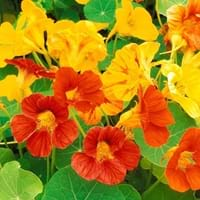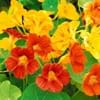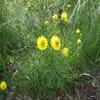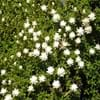Life Span
Annual
Perennial
Origin
South America
China
Types
Annuals
Not Available
Habitat
Cultivated Beds
Forest margins, gardens, Grassland, Tropical regions
USDA Hardiness Zone
8-11
8-15
AHS Heat Zone
12 - 1
12 - 1
Sunset Zone
A1, A2, A3, H1, H2, 1a, 1b, 2a, 2b, 3a, 3b, 4, 5, 6, 7, 8, 9, 10, 11, 12, 13, 14, 15, 16, 17, 18, 19, 20, 21, 22, 23, 24
H1, H2, 8, 9, 14, 15, 16, 17, 18, 19, 20, 21, 22, 23, 24
Habit
Cushion/Mound-forming
Clump-Forming
Minimum Width
Not Available
Flower Color
Yellow, Red, Orange
Not Available
Flower Color Modifier
Bicolor
Bicolor
Fruit Color
Green, Tan
Not Available
Leaf Color in Spring
White, Light Green
Light Green, Dark Green
Leaf Color in Summer
White, Light Green
Light Green
Leaf Color in Fall
White, Light Green
Light Green, Dark Green
Leaf Color in Winter
Light Green
Light Green, Dark Green
Leaf Shape
Orbicular
Grass like
Plant Season
Spring, Summer
Spring, Summer, Fall, Winter
Sunlight
Full Sun, Partial Sun
Full Sun, Partial Sun, Partial shade
Type of Soil
Loam, Sand
Loam, Sand
The pH of Soil
Neutral
Acidic, Neutral, Alkaline
Soil Drainage
Well drained
Average
Bloom Time
Late Spring, Early Summer, Summer, Late Summer, Early Fall
Not Available
Tolerances
Drought
Drought
Where to Plant?
Container, Ground
Ground, Pot
How to Plant?
Seedlings
Seedlings, Transplanting
Plant Maintenance
Medium
Medium
Watering Requirements
Medium
Keep the ground moist but not water-logged, Requires regular watering, Use and maintain water-efficient soaker hoses, Use Mulches to help prevent water loss during hot and windy weather, Water every two or three days during warmer months, Water twice a day in the initial period
In Summer
Lots of watering
Lots of watering
In Spring
Moderate
Moderate
In Winter
Average Water
Average Water
Soil pH
Acidic, Alkaline, Neutral
Acidic, Neutral, Alkaline
Soil Type
Loamy, Sandy, Well drained
Loam, Sand
Soil Drainage Capacity
Well drained
Average
Sun Exposure
Full Sun
Full Sun, Partial Sun, Partial shade
Pruning
Remove damaged leaves, Remove dead branches, Remove dead leaves
Remove damaged leaves, Remove dead branches, Remove dead leaves
Fertilizers
All-Purpose Liquid Fertilizer
All-Purpose Liquid Fertilizer
Pests and Diseases
Red blotch
Red blotch
Plant Tolerance
Drought
Drought
Flower Petal Number
Single
Single
Foliage Texture
Medium
Medium
Foliage Sheen
Matte
Matte
Attracts
Hummingbirds, Butterflies
Birds
Allergy
Not Available
no allergic reactions
Aesthetic Uses
Landscape Designing, Showy Purposes
Beautification
Beauty Benefits
Not Available
Not Available
Environmental Uses
Air purification
Air purification
Medicinal Uses
Antibacterial, Antibiotic, Anti-fungal, Antiseptic, Depurative, Diuretic, Emmenagogue, Expectorant, Stimulates new cell growth
Not Available
Part of Plant Used
Flowers, Leaves
Whole plant
Other Uses
Oil is used as an industrial solvent, Used as an insecticide, Used As Food, Used as Ornamental plant
Culinary use, Used in construction, Used in Furniture, Used in making musical instruments, Used in paper industry
Used As Indoor Plant
Yes
No
Used As Outdoor Plant
Yes
Yes
Garden Design
Container, Groundcover
Container, Feature Plant, Hedges, Screening / Wind Break, Tropical
Botanical Name
TROPAEOLUM majus
BAMBUSA multiplex 'Alphonso-Karrii'
Common Name
Indian Cress, Nasturtium
Alphonse Karr Bamboo, Clumping Bamboo, Hedge Bamboo
In Hindi
Tropaeolum majus
अल्फोंस Karr बांस
In German
Tropaeolum majus
Alphonse Karr Bamboo
In French
Tropaeolum majus
Alphonse Karr Bamboo
In Spanish
Tropaeolum majus
Alphonse Karr Bambú
In Greek
Tropaeolum majus
Alphonse Karr Μπαμπού
In Portuguese
Tropaeolum majus
Alphonse Karr Bamboo
In Polish
nasturcja większa
Alphonse Karr Bamboo
In Latin
Tropaeolum majus
Alphonse Karr Bamboo
Phylum
Magnoliophyta
Not Available
Class
Magnoliopsida
Not Available
Family
Tropaeolaceae
Poaceae
Clade
Angiosperms, Eudicots, Rosids
Angiosperms, Commelinids, Monocots
Tribe
Not Available
Bambuseae
Subfamily
Not Available
Bambusoideae
Number of Species
Not Available
Importance of Nasturtium and Alphonse Karr Bamboo
Want to have the most appropriate plant for your garden? You might want to know the importance of Nasturtium and Alphonse Karr Bamboo. Basically, these two plants vary in many aspects. Compare Nasturtium and Alphonse Karr Bamboo as they differ in many characteristics such as their life, care, benefits, facts, etc. Every gardener must at least have the slightest clue about the plants he wants to plant in his garden. Compare their benefits, which differ in many ways like facts and uses. The medicinal use of Nasturtium is Antibacterial, Antibiotic, Anti-fungal, Antiseptic, Depurative, Diuretic, Emmenagogue, Expectorant and Stimulates new cell growth whereas of Alphonse Karr Bamboo is Not Available. Nasturtium has beauty benefits as follows: Not Available while Alphonse Karr Bamboo has beauty benefits as follows: Not Available.
Compare Facts of Nasturtium vs Alphonse Karr Bamboo
How to choose the best garden plant for your garden depending upon its facts? Here garden plant comparison will help you to solve this query. Compare the facts of Nasturtium vs Alphonse Karr Bamboo and know which one to choose. As garden plants have benefits and other uses, allergy is also a major drawback of plants for some people. Allergic reactions of Nasturtium are Not Available whereas of Alphonse Karr Bamboo have no allergic reactions respectively. Having a fruit bearing plant in your garden can be a plus point of your garden. Nasturtium has no showy fruits and Alphonse Karr Bamboo has no showy fruits. Also Nasturtium is not flowering and Alphonse Karr Bamboo is not flowering . You can compare Nasturtium and Alphonse Karr Bamboo facts and facts of other plants too.





